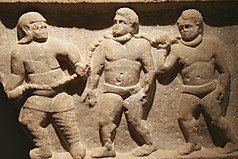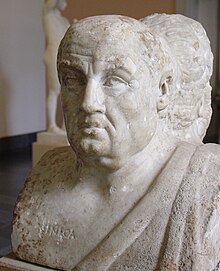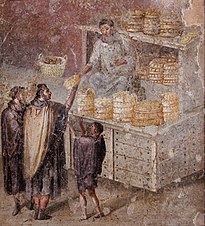Poverty in ancient Rome
This article, Poverty in ancient Rome, has recently been created via the Articles for creation process. Please check to see if the reviewer has accidentally left this template after accepting the draft and take appropriate action as necessary.
Reviewer tools: Inform author |
This article, Poverty in ancient Rome, has recently been created via the Articles for creation process. Please check to see if the reviewer has accidentally left this template after accepting the draft and take appropriate action as necessary.
Reviewer tools: Inform author |
 Comment: Stated facts should be backed up with inline citations to reliable sources. Currently large portions of text are unsourced, please fix this before resubmitting. -Liancetalk/contribs 15:50, 9 August 2022 (UTC)
Comment: Stated facts should be backed up with inline citations to reliable sources. Currently large portions of text are unsourced, please fix this before resubmitting. -Liancetalk/contribs 15:50, 9 August 2022 (UTC)
Poverty in ancient Rome is difficult to define. This is due to their lack of significant coverage in the historical record, and the difficulty in defining the lines between poverty and middle class. Roman writers describe the poorer parts of the population as unvirtuous and immoral masses who are threats to the nation and unconcerned with the values of the Roman world. Ancient Roman Christian depictions tend to depict the poor as more sympathetic and often call for the wealthy to help them. There were other efforts to help the poor, such as the Cura Annonae, which was policy which redistributed grain. The poor also had limited rights. They were unable to access political offices, had higher tax rates, and were unable to afford most status symbols.
Definition

It can be difficult to define ancient Roman poverty. The conditions of most people in the Roman world resembled modern ideas of poverty. They had high rates of infant mortality, poor diet, and low rates of literacy. Poverty was also not regarded as a problematic or unacceptable condition, which differs from the modern understanding of it. It is also unclear if there was a group of people which were noticeably more poor than other groups. Another possibility is that the Roman economy allowed civilians meeting the criteria for the modern understanding of poverty to not live a life resembling the modern understanding of poverty. Roman writers only make a distinction between the wealthy upper-class patricians and the rest of the population. They don't distinguish between the rest of the plebian class, and treat all of them as if they were a homogenous mass. Roman poverty can be defined by the lack of presence in the historical record. Archaeological evidence of poorer classes and people of low-status in ancient Rome is rare.[1]
The Roman senate defined the groups known as the ordines. These were the equites, curiales, and the senators. The classes below these ones were known as the humiliores. It is unclear to what extent these classes were representative of economic inequality. They may have been political classes rather than economic ones.[2] Another uncertainty is the presence of a Roman middle class. Their society may have consisted of a handful of wealthy individuals which made up 0.6% of the population, an army that made up 0.4% of the population, and the poor masses that made up 99% of the populace. Other scholars, such as William Harris divided Roman society into three economic classes. Those that relied on other's work, those were well-off although they still worked, and the slaves and menial laborers. However there is little archaeological evidence that can pinpoint who belonged to these classes. Scholars are also unsure if these views of Roman society are overly dichotomous, and if the real Roman economy was far more nuanced and complex.[3]
Social Status and Stigma

Wealth in ancient Rome was a status symbol, and many expensive objects, such as large houses were also status symbols.[4] In the Roman Republic political privileges were often restricted to the wealthy. Although most rights and privileges were based off of citizenship status, rather than economic status. The Roman military typically employed the poorer members of the Roman population. By the end of a campaign, the poverty-stricken populace was in a position to demand reforms or relief.[5] During earlier periods of Roman history the poor were considered to be virtuous and poverty was considered honorable. Stoic philosophers such as Seneca and Epicurus believed that poverty could lead to contentment with life, and that increasing wealth did not reduce the problems a persons suffered from, but merely altered it.[6] By the late Republic the poor were considered to beneath others and to be lower in prestige and virtue than other social castes. Writers described them as incapable of any lasting virtue. They were considered to be a mass a peasants that was easily swayed and a threat to political stability. Roman writers also considered the poor to only be concerned with "bread and circuses," rather than the intricacies and values of Roman society. Martial's epigrams compare the poor to dogs.[7] Roman cities and settlements were typically designed to geographically separate the living spaces of the rich from those of the poor. This social stigma likely reinforced the economic inequality and the social stratification present in ancient Rome. Wealthy Romans were terrified of poverty, and the humiliations and social ostracization that came along with it.[8][9] By the reign of Marcian in the 5th Century CE poverty was no longer seen as shameful.[10]
Financial aid

There was the Cura Annonae, which was a program to redistribute grain amongst the populace.[11] Cicero, a Roman politician and writer stated that excess wealth should be spend on helping others. He specified that it should be given to the neediest of the populace, rather than individuals who did not need financial aid. Cicero also believed that all of the beneficiaries of this aid should be respectable members of the population who would use the aid to try and escape poverty. Despite these cultural beliefs upper-class Romans were far more likely to help others members of the upper-class than they were they were to help poorer civilians. Other motivations for aiding the poor came from a fear of public humiliation or of being harmed in some way by the poor. Roman writers described beggars dressed in rags spread throughout the streets asking for aid. They were said to be almost always elderly, and some were alleged to have blinded their own children to make them more sympathetic.[12]
Causes
The poor in Roman society had little or no access to land or property. Those who owned land were capable of using that land to generate more wealth or cultivate resources. Land also the most common item used as security in loans. Poorer civilians were often relegated to working alongside slaves, although this provided an irregular source of income. Debt was another major factor that contributed to ancient Roman poverty. Loans usually had high interest rates and were required to be paid back under threat of harsh penalties. The Roman government imposed high rates of taxation on the poorer parts of the Roman population. While the wealthy payed little in taxes.[13] Poor Romans also faced difficulties finding jobs with adequate pay. It was extremely improbable for a worker to find enough work to properly support a family of three.[14]
Effects

Poor Romans often sold themselves or their child into slavery. The disabled population of Rome had to rely on the goodwill of other people in order to survive and to not live in poverty. According to Ammianus Marcellinus, a Roman historian the Roman poor lived in building's crevices, tabernae, or vaults beneath theaters or circuses.[15] They also lived in low-quality apartment buildings called Insulae.[16] Poor Romans were especially vulnerable during crises, and they were at risk of facing crises such as food shortages or being the victims of crime. The poorest parts of the Roman population were unable to afford most forms of social interaction and demonstrations of status. Such as baths, dinners, or collegia.[17] Poor Romans were barred from political positions and certain activities. Emperor Constantine enacted a law prohibiting unvirtuous women from marrying high-status men. Poor individuals in general were banned from marrying people above their social status. It was unclear if the poor belonged to this group. Roman law did not define the poor as a group. Poorer Romans were also buried in puticuli, which were mass burials used to entomb poor Romans.[18] It was also difficult for the poor to find jobs due to slavery. People would purchase slaves rather than pay workers.[19][20]
Christianity
Christians in ancient Rome sought to highlight the poorer members of Roman society and to bring attention to their struggles. John Chrysostom, a saint, a Church father, and the Archbishop of Constantinople argued that if the wealthy were to redistribute their wealth and fortune amongst the populace "you would have difficulty in finding one poor person for every fifty or even every hundred of the others." Paulinus' epistulae describes Christians organizing mass events designed to provide alms and gifts for the poor. However, it is possible he made this story up. Christian interpretations of the poor in ancient Rome didn't differentiate between differing groups of poor people. They depicted them as a homogenous mass in line with previous negative outlooks on those stuck in poverty. However Christian depictions did not portray poverty as immoral or unvirtuous. Augustine, a Catholic theologian, describes beggars as immoral criminals who acted in unvirtuous ways and were far from God. However he also portrayed obsession with wealth and accruing money as like begging and only resulting in dissatisfaction with life. Augustine also believed that Jesus taught that people should aid beggars, and wrote that people should redirect their from the poor, and towards the wealthy. Jesus himself was frequently associated with poverty.[21]
References
- ^ Osbourne & Atkins 2011, p. 21-36.
- ^ Osbourne & Atkins 2011, p. 9-11.
- ^ Osbourne & Atkins 2011, p. 45-46.
- ^ Edwards 1993, p. 151-154.
- ^ Osbourne & Atkins 2011, p. 8-9.
- ^ Osbourne & Atkins 2011, p. 13-15.
- ^ Osbourne & Atkins 2011, p. 95.
- ^ Silver 2007, p. 225.
- ^ Osbourne & Atkins, p. 90.
- ^ Osbourne & Atkins, p. 183-184.
- ^ Osbourne & Atkins 2011, p. 9-10.
- ^ Harris 2011, p. 39-40.
- ^ Harris 2011, p. 34.
- ^ Harris 2011, p. 28.
- ^ Osbourne & Atkins 2011, p. 24-26.
- ^ Neumeister 1993, p. 23.
- ^ Osbourne & Atkins 2011, p. 42.
- ^ Erdkamp 2013, p. 99.
- ^ Morley 1998, p. 102.
- ^ Osbourne & Atkins, p. 45.
- ^ Osbourne & Atkins 2011, p. 130-144.
Bibliography
- Osbourne, Robin; Atkins, Margaret, eds. (October 9, 2006), Poverty in the Roman World (1st ed.), New York: Cambridge University Press, doi:10.1017/CBO9780511482700, ISBN 978-0521106573, archived from the original (PDF) on August 4, 2022, retrieved August 4, 2022.
- Edwards, Catherine (February 26, 1993), "Structures of immorality: Rhetoric, building, and social hierarchy", Politics of Immortality in ancient Rome (PDF), Cambridge: Cambridge University Press, doi:10.1017/CBO9780511518553, ISBN 978-051-151-855-3, archived from the original on August 8, 2022, retrieved August 8, 2022.
- Erdkamp, Paul, ed. (September 30, 2013), The Cambridge Companion to Ancient Rome, Cambridge: Cambridge University Press, doi:10.1017/CCO9781139025973, ISBN 978-113-902-597-3, archived from the original (PDF) on August 8, 2022, retrieved August 8, 2022.
{{citation}}:|archive-date=/|archive-url=timestamp mismatch; 2018-06-16 suggested (help) - Neumeister, Christoff (1993), Urban Culture in Ancient Rome, vol. 2, Anthropological Journal on European Cultures, retrieved August 8, 2022.
{{citation}}:|archive-date=requires|archive-url=(help) - Morley, Nevilel (1998), Political Economy and Classical Antiquity, vol. 59, Journal of the History of Ideas, doi:10.2307/3654056, JSTOR 3654056, retrieved August 8, 2022
- Silver, Moris (2007), ROMAN ECONOMIC GROWTH AND LIVING STANDARDS: PERCEPTIONS VERSUS EVIDENCE, vol. 37, retrieved August 8, 2022
- Harris, W.V. (February 3, 2011), Rome's Imperial Economy: Twelve Essays, New York: Oxford University Press, retrieved August 9, 2022.

